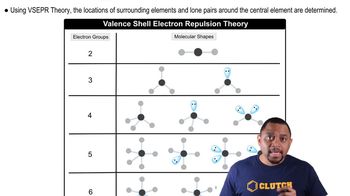Textbook Question
Determine the molecular geometry about each interior atom and sketch each molecule. c. N2H4 (skeletal structure H2NNH2)
874
views
 Tro 4th Edition
Tro 4th Edition Ch.10 - Chemical Bonding II: Molecular Shapes & Valence Bond Theory
Ch.10 - Chemical Bonding II: Molecular Shapes & Valence Bond Theory Problem 46c
Problem 46c Verified step by step guidance
Verified step by step guidance



Determine the molecular geometry about each interior atom and sketch each molecule. c. N2H4 (skeletal structure H2NNH2)
Each ball-and-stick model shows the electron and molecular geometry of a generic molecule. Explain what is wrong with each molecular geometry and provide the correct molecular geometry, given the number of lone pairs and bonding groups on the central atom. (c)
Determine the geometry about each interior atom in each molecule and sketch the molecule. (Skeletal structure is indicated in parentheses.) c. H2O2 (HOOH)
Explain why CO2 and CCl4 are both nonpolar even though they contain polar bonds.
CH3F is a polar molecule, even though the tetrahedral geometry often leads to nonpolar molecules. Explain.
Determine whether each molecule in Exercise 35 is polar or nonpolar. a. PF3 b. SBr2 c. CHCl3 d. CS2